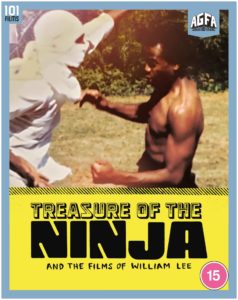
Treasure of the Ninja is a 1987 American kung-fu action thriller, written/directed/starring William Lee. Lee is well-known for his thirty-something years in independent filmmaking, well versed in the trials and tribulations of working in the face of adversity.
In the country of Ranga, Dr. Melissa Stewart and her colleague, Rodger, are in search of the legendary Treasure of Kamchia, one of the last great mysteries of the archaeological world. However, after catching the attention of the island-owning killer, Steven Chase, and his band of ninjas, the pair are unfortunately captured and held prisoner. It’s up to Magneta Faze, a US government-trained ninja, and his teenage genius partner, Monique, to foil Chase’s evil plans, rescue the pair and find the Treasure of the Ninja!

Inspired as a child by legendary martial artist Bruce Lee, William’s wish was to recreate these incredible feats of cinema himself. After attaining a camera, the young filmmaker set off to pay homage to these masterpieces of film, albeit on a smaller scale with his friends. Within a year, William had received his first film award from the Eye Music Festival of San Francisco. Uninterested in the “hood/ghetto/gangsta” genre of films that seem to be so prevalent in black cinema at the time, William struggled to acquire funding for his projects; companies were unwilling to take the risk of funding his work in bias of an African-American’s ability to direct and produce a money-making film outside this ethnically associated trend.
Besides the odd obscure film festival screening or sales of VHS-quality copies on independent film sites, William’s work was practically unnoticed in the industry for several decades. Despite this, the filmmaker never gave up on his dream: to be seen not as a black filmmaker, but as a filmmaker who makes non-stereotypical, well-written action films with a message.
Being one of William’s first feature-length films, Treasure of the Ninja features an incredibly in-depth story. Full of magnetism, unexpected supernatural twists, and intricate fight choreography reminiscent of Bruce Lee’s techniques (though executed with less expertise) that lead to an interesting 1 hour 45 min romp of independent kung-fu action. Although produced on a shoestring budget of only $1500, the film’s sheer ambition would suggest much larger funding was procured. With an incredibly large cast, dozens of filming locations as well as an earnest story, the minimal budget was utilized effectively to produce a film of notable quality.

However, Treasure of the Ninja does suffer from the follies of an independent production such as this. Filmed on an old Super 8 film camera without audio, the quality of the overdub borders on dubious at points. It consequently suffers from a mix of poor synchronisation as well as inadequate line delivery from certain characters. In addition, the use of natural lighting leaves certain scenes incredibly underlit and causes difficulty in distinguishing certain aspects of a scene. These imperfections, though discernible throughout, certainly add to the overall charm of the production, rarely causing any real distraction.
Only being available on VHS for the majority of its existence, that is finally about to change thanks to the American Genre Film Association (AGFN) and Bleeding Skull, in association with 101 Films’ release of Treasure of the Ninja and the Films of William Lee. A Blu-ray release of a 2K upscale of the original VHS release of Treasure of the Ninja, special features includes a 2K upscale of the original Super8 element of The New Chinese Connection (1980), Dragon Vs Ninja (1984), and the Willie Jack series of shorts all produced by William. This release is available to pre-order from 101 Films’ website now (released July 18th).

A piece of cinema displayed in its purest form, Treasure of the Ninja is an impassioned production created from one man’s love of film and unwillingness to admit defeat in the face of adversity. Featuring an amazing 80s electronic soundtrack, some great fight scenes, and a well-written story, there has never been a better time to experience the unique filmmaking of William Lee.

More From 101 Films
As a young girl who grew up stuffing my barbies into a toy replica of the monster truck Big Foot, Monster Man screamed out to me. What’s not to love about a… Pop culture is currently experiencing a boom of 1980s nostalgia. From Stranger Things on Netflix to Grady Hendrix’s My Best Friend’s Exorcism, science fiction and horror are squeezing every last… Caged Heat is a 1974 American women-in-prison exploitation film, written and directed by Jonathan Demme and released under Roger Corman’s New World Pictures. Though the film would be his directorial… Jane (2022), directed and co-written by Sabrina Jaglom, is a supernatural, psychological thriller. Rishi Rajani also joins the writing credits. While Jaglom has a short she directed and production credits…Monster Man (2003) Film Review: Monster Truck Mayhem!
The Brain (1988) Film Review | Food for Thought
Caged Heat (1974) Film review – I Know Why the Caged Bird Sings
Jane (2022) Film Review: Psychological, Supernatural Horror

Hey there, I’m Jim and I’m located in London, UK. I am a Writer and Managing Director here at Grimoire of Horror. A lifelong love of horror and writing has led me down this rabbit hole, allowing me to meet many amazing people and experience some truly original artwork. I specialise in world cinema, manga/graphic novels, and video games but will sometime traverse into the unknown in search of adventure.



